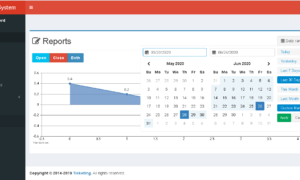Capstone Project Ideas for Accounting Information System
Introduction
Table of Contents
Accounting Information Systems (AIS) are specialized systems designed to collect, store, and process financial and accounting data. These systems help businesses automate their accounting processes, ensuring accuracy, efficiency, and compliance with financial regulations.
In today’s fast-paced business environment, AIS plays a crucial role in managing finances, reducing manual errors, and improving decision-making. By integrating financial data into a centralized system, businesses can generate accurate financial reports, monitor expenses, and maintain control over cash flow.
AIS is a popular choice for capstone projects because it combines technology and accounting, offering students an opportunity to create solutions that address real-world financial challenges. Developing an AIS project allows students to apply their technical skills and accounting knowledge to build practical systems that can help businesses streamline their operations.
What is an Accounting Information System?
An Accounting Information System (AIS) is a framework that businesses use to collect, store, manage, and process financial data. It integrates accounting practices with technology to automate key financial tasks, ensuring accuracy and efficiency in managing financial information.
Components of an AIS:
- People: Users who manage, operate, and interact with the system (accountants, auditors, and financial managers).
- Data: Financial transactions, such as sales, expenses, payroll, and inventory.
- Procedures: Policies and processes for handling financial data.
- Software: Programs that process and manage financial data (e.g., QuickBooks, SAP, Oracle).
- IT Infrastructure: Hardware and networks that support the AIS.
- Internal Controls: Security measures to safeguard financial data and ensure compliance with regulations.
Key Functions and Processes Automated by AIS:
- Transaction Processing: Automates the recording of sales, purchases, and other financial transactions.
- Financial Reporting: Generates accurate financial statements like balance sheets, income statements, and cash flow reports.
- Payroll Management: Automates salary calculations, tax deductions, and employee payment processes.
- Auditing: Ensures compliance with accounting standards, detects errors, and provides audit trails for transactions.
- Budgeting and Forecasting: Helps businesses plan finances and forecast future revenue and expenses.
Examples of AIS in Different Industries:
- Retail: Tracks sales transactions, manages inventory, and handles customer payments.
- Healthcare: Manages billing, insurance claims, and payroll for healthcare workers.
- Manufacturing: Tracks production costs, manages supplier payments, and handles financial reporting.
- Non-Profit: Monitors donations, fund allocation, and ensures transparency for stakeholders.
An effective AIS helps businesses across industries enhance financial accuracy, streamline processes, and make informed decisions based on real-time data.
Capstone Project Ideas for Accounting Information Systems
Here are 15 innovative and practical project ideas for Accounting Information Systems (AIS) capstone projects, along with descriptions and recommended development tools:
- Web-Based Accounting System for Small Businesses
- Description: Develop an online platform for managing financial transactions, including income, expenses, and financial reports. Tailored for small businesses to help streamline bookkeeping.
- Tools: PHP, MySQL, Laravel, Bootstrap, JavaScript
- Cloud-Based Payroll Management System
- Description: Create a cloud-based payroll system that automates employee salary processing, tax deductions, and generates pay slips.
- Tools: Python (Django), PostgreSQL, AWS, HTML/CSS
- Inventory and Expense Tracking System
- Description: Build a system for tracking inventory purchases, expenses, and linking them to sales transactions for real-time financial insights.
- Tools: Java, Spring Boot, MySQL, React
- Financial Forecasting and Budgeting Tool
- Description: Design a system that enables businesses to set budgets and forecast financial performance based on historical data.
- Tools: R, Flask, SQLite, Chart.js
- Tax Filing and Compliance Automation System
- Description: Develop an application that automates tax filing for businesses, ensuring compliance with local tax regulations and generating tax reports.
- Tools: Node.js, Express.js, MongoDB, Angular
- Blockchain-Based Accounting Ledger
- Description: Create an accounting system using blockchain to ensure transparency, data integrity, and security in financial transactions.
- Tools: Solidity, Ethereum Blockchain, Web3.js, React
- E-Commerce Accounting Integration System
- Description: Build an AIS that integrates with e-commerce platforms like Shopify or WooCommerce, tracking sales, inventory, and revenue in real-time.
- Tools: PHP, WooCommerce API, MySQL, Laravel
- Accounts Receivable and Payable System
- Description: Develop a system to automate accounts receivable (AR) and accounts payable (AP) processes, including invoicing and payments.
- Tools: C#, .NET Core, MSSQL, Vue.js
- Real-Time Expense Monitoring Dashboard
- Description: Create a real-time dashboard for businesses to track their daily expenses, categorize spending, and generate financial summaries.
- Tools: Python (Flask), MongoDB, Plotly, HTML/CSS
- Non-Profit Organization Fund Management System
- Description: Build an accounting system designed for non-profit organizations to manage donations, grants, and fund allocations with transparency.
- Tools: Ruby on Rails, PostgreSQL, jQuery, Bootstrap
- Automated Auditing System
- Description: Create a tool that performs automated audits, flags discrepancies in financial data, and generates detailed audit reports.
- Tools: Java, Hibernate, MySQL, Apache Kafka
- Multi-Currency Accounting System
- Description: Design an accounting system that supports multi-currency transactions, automates currency conversions, and tracks gains or losses from exchange rates.
- Tools: Python, Django, SQLite, Open Exchange Rates API
- Student Fee Management System
- Description: Develop a fee management system for educational institutions to track student payments, generate receipts, and manage outstanding balances.
- Tools: PHP, CodeIgniter, MySQL, jQuery
- Construction Accounting and Job Costing System
- Description: Create a system for tracking construction project costs, including labor, materials, and overhead, and linking it to accounting processes.
- Tools: C#, .NET Core, MSSQL, React
- Fraud Detection and Prevention System for Accounting
- Description: Design a system that uses machine learning to detect and flag suspicious financial activities and prevent fraud in accounting transactions.
- Tools: Python, TensorFlow, Flask, SQLite
How to Choose the Right Capstone Project for AIS
Choosing the right Accounting Information System (AIS) capstone project is essential to ensure a successful outcome. Here are some tips to help you select a project that aligns with your interests, resources, and future goals:
- Follow Your Interest and Passion
- Choose a topic that excites you: Select a project idea that genuinely interests you, whether it’s automating payroll systems or designing a real-time expense tracker. Passion will keep you motivated throughout the development process.
- Identify areas of strength: Consider your knowledge and interest in specific accounting processes like financial reporting, auditing, or tax management, and pick a project that allows you to apply those skills.
- Evaluate Available Resources and Technical Skills
- Assess your technical abilities: Consider the programming languages, frameworks, and databases you’re familiar with. Select a project that matches your skillset or offers an opportunity to expand your technical expertise without being overwhelming.
- Check resource availability: Ensure you have access to the necessary tools, software, and datasets. For example, if you’re building a cloud-based system, make sure you can access cloud services like AWS or Google Cloud.
- Consider Relevance to Industry or Future Career Goals
- Align with career aspirations: If you want to work in a particular industry (e.g., retail, banking, non-profits), choose a project that reflects real-world accounting needs in that field.
- Focus on in-demand skills: Projects that use emerging technologies like blockchain, cloud computing, or AI-based fraud detection can boost your resume and prepare you for the evolving job market.
- Understand the Complexity and Scope of the Project
- Balance ambition with feasibility: While it’s important to challenge yourself, be mindful of the project’s complexity. Ensure that the project can be completed within your timeframe and with the resources available to you.
- Define clear objectives: Break down your project into smaller, manageable tasks and milestones. A project with a clear scope and timeline is easier to execute and track.
By considering these factors, you’ll be able to select a capstone project that is not only feasible but also meaningful to your academic journey and future career in Accounting Information Systems.
Methodology for Developing an AIS Capstone Project
Here’s a step-by-step guide to help you successfully develop an Accounting Information System (AIS) capstone project:
- Define the Problem Statement and Objectives
- Identify the problem: Clearly define the accounting issue or process you aim to improve or automate with your AIS project. For example, it could be automating payroll, streamlining inventory management, or enhancing financial reporting.
- Set clear objectives: Specify what your system should achieve, such as reducing manual errors, improving efficiency, or generating real-time financial insights.
- Conduct a Literature Review and Explore Existing AIS Solutions
- Research existing solutions: Review academic papers, case studies, and existing software solutions to understand how other systems address similar accounting challenges.
- Identify gaps and opportunities: Based on your research, identify areas where your project can offer improvements, such as better user experience, additional features, or advanced reporting tools.
- Plan System Architecture and Features
- Design system architecture: Outline the overall structure of your AIS, including front-end interfaces, back-end databases, and any APIs or third-party services you’ll use.
- Define key features: List essential features such as transaction processing, reporting, and user roles (e.g., admin, accountant, auditor). Consider security measures like encryption and access control.
- Choose the Right Development Tools
- Programming Languages: Choose languages that fit your project needs. For web-based systems, PHP, JavaScript, or Python are common choices. For desktop applications, consider Java or C#.
- Databases: Select a database that fits your data structure and scalability needs. Common options include MySQL, PostgreSQL, or SQLite for small-scale projects.
- Frameworks and Libraries: Depending on your project, use frameworks like Laravel (PHP), Django (Python), or Spring Boot (Java) to speed up development and ensure security.
- Develop, Test, and Deploy the System
- Develop the system: Start building the system based on the architecture and features you’ve defined. Follow best coding practices and ensure that the system is modular and scalable.
- Test thoroughly: Conduct various tests, including unit testing, system testing, and user acceptance testing. Ensure all features work as intended and that the system is free from bugs.
- Deploy the system: Once testing is complete, deploy your system in a live environment (cloud-based, local server, or web-based platform) and ensure smooth operations.
- Conduct System Evaluation and Gather Feedback
- Evaluate system performance: Monitor the system for performance issues such as speed, reliability, and data integrity. Use benchmarks or KPIs (Key Performance Indicators) to assess success.
- Gather user feedback: Engage with users (e.g., accountants, managers) to gather feedback on the system’s usability and effectiveness. Use their insights to refine and improve the system.
By following these steps, you can systematically build a robust Accounting Information System that addresses real-world accounting challenges while ensuring quality and scalability.
Jewelry Sales Accounting and Appraisal System Free Download PHP Template
Conclusion
Accounting Information Systems (AIS) play a crucial role in modern business and accounting, streamlining processes, improving accuracy, and enabling data-driven decision-making. Whether it’s automating payroll, managing inventory, or generating financial reports, AIS helps businesses operate more efficiently and effectively.
For students, developing an AIS capstone project presents an excellent opportunity to apply their knowledge and skills to real-world problems. By pursuing creative and innovative project ideas, you can not only enhance your technical and analytical abilities but also make a meaningful impact on businesses and the accounting profession. Take the challenge, and build a project that could shape the future of accounting systems.
You may visit our Facebook page for more information, inquiries, and comments. Please subscribe also to our YouTube Channel to receive free capstone projects resources and computer programming tutorials.
Hire our team to do the project.


